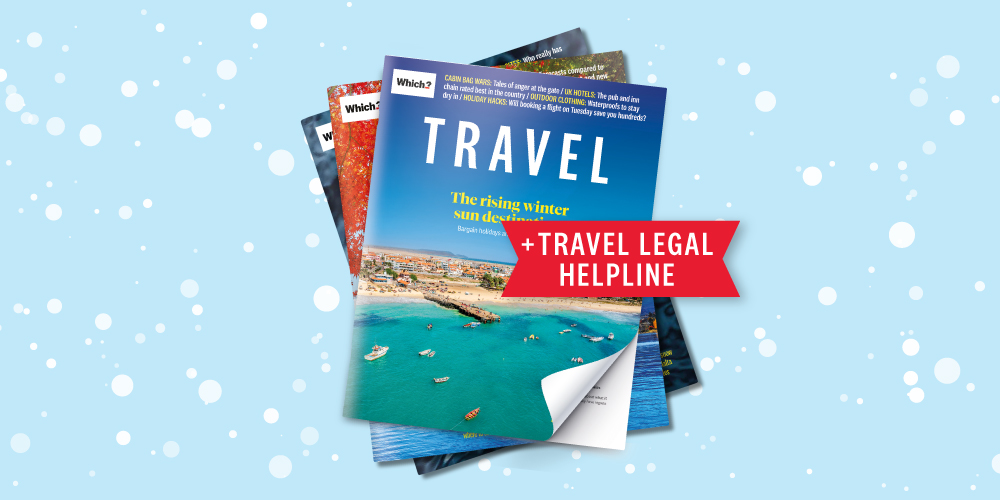
Get a year of super-useful advice
Who to book with, how to get the best deals plus inspiring destination ideas from the experts, for only £36.75 for the year – that’s 25% off.
Join Which? TravelOffer ends 8th January 2026

Whether striding out on a sun-drenched jaunt in summer or a drizzly hike in winter, an excellent pair of walking trousers will prevent chafing, protect your skin and let you move freely. It's always a better option than jeans – especially if you buy a pair from a best-rated walking trousers brand.
Because of the synthetic fibres they're often made from, walking trousers should dry out quickly if they get wet, unlike denim.
Just be sure to try them on before you buy to make sure they're a good fit without being restrictive - nobody needs a pair that'll tear as you climb over a stile.
Get travel advice and recommendations you can trust from our experts with our Travel newsletter – it's free
Specialised walking trousers will make things more comfortable. Trousers such as jeans don't tend to provide the stretch you'll need for clambering uphill or hopping across streams. Denim can also be rough on the skin and may cause chafing – especially when wet.
Meanwhile, leggings aren't as durable and could easily snag if you brush up against brambles or plan to scramble up a mountain.
Discover the best-rated UK walks – as rated by Which? members

Whether your pair has an elasticated waist, loops with a belt you can adjust, or both, an adjustable waist is essential to prevent your trousers from slipping down while you walk.
When selecting trousers for a hike, avoid any made solely or mostly of cotton. They won't dry quickly if you get drenched or wick away sweat, nor will they withstand high levels of abrasion.
A fully synthetic pair (such as polyester, polyamide and/or elastane) is the best option as they're lightweight and quick-drying, but a mix of cotton and a synthetic fibre will suffice.
Consider thicker fleece-lined trousers if you're hiking in freezing conditions.
Lighter trousers with a brushed inner side will be cooler and more breathable at other times.
You can always put on a base layer made of Merino wool if temperatures dip; the material is excellent for keeping you cool when it's hot and warm when it's cold, as well as wicking away sweat.
If you tend to walk with a rucksack, you may want to choose a pair with a lower cut, as they'll sit more neatly underneath. Look out for this in the features on the label, or in the online description.
Walking trousers are not designed to be waterproof. The more waterproof something is, the less breathable it's likely to be. Instead, buy a separate pair of waterproof overtrousers that you can pull on over the top in a downpour. Find out the overtrousers brands Which? members rated highly.
Well-designed pockets are essential for storing items, such as a phone and map, within easy reach. It’s not unusual for walking trousers to have eight or more pockets, so you may want to look out for a pocket designed specifically for your mobile, a hidden security pocket, roomy cargo pockets and pockets to keep your hands warm.
It’s a matter of personal preference whether you prefer buttons, zips, poppers or Velcro, but you’ll want to make sure at least one or two pockets can be fastened securely to stop your valuables falling out if you’re crossing a stream.
If you’ll be carrying more than you can fit into your pockets, take a look at our best backpack reviews.
Simply put, you need your hiking trousers to move with you. To ensure they do this, look for darts at the knees (horizontal lines touching the inseam and outseam) to ensure your movement won't be restricted. The narrower the cut of the trousers, the more important this is.
Velcro tabs on the ankles are worth considering as they can be tightened to keep the wind out or loosened to give you a bit of ventilation if you’ve worked up a sweat.
For days when you’re not quite sure what the weather will do, you could invest in a pair of ‘convertible’ walking trousers.
Wear them as trousers until you’ve warmed up, then unzip the bottom part to make them into shorts.
Full-length trousers, provided they aren't too thick or fleecy, are still useful in summer to protect you from sunburn. Plus, they’re useful if you find shorts more comfortable in the day, but want to stop bugs from getting to you in the early evening.

Who to book with, how to get the best deals plus inspiring destination ideas from the experts, for only £36.75 for the year – that’s 25% off.
Join Which? TravelOffer ends 8th January 2026

Polyester blend fabrics are tougher than cotton or nylon. Additionally, look for trousers with double- or triple-stitched seams as they're likely to be more robust than those with single seams.
Finally, reinforced knees or seats should hold out even if you're scrambling over rocky terrain, or sit on a scree slope for a quick break.
Take a look at the best-rated walking trouser brands – as rated by Which? members – to discover the brands with good durability and customer scores.
Like you would with regular trousers, try them on before you buy. Test them by stretching and bending as much as you can in the shop, to make sure they won’t restrict you when you’re climbing over a stile, for instance.
Ensure the waistband is adjustable, not just for the fit, but so that you can tuck in your top to keep the wind out. And you could look out for a waistband lined with a soft material to reduce the chance of chafing and irritation.
For more outdoor clothing tips and brand recommendations, plus more unbiased news and advice, sign up to Which? Travel's newsletter – it's free